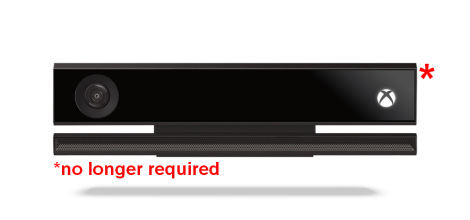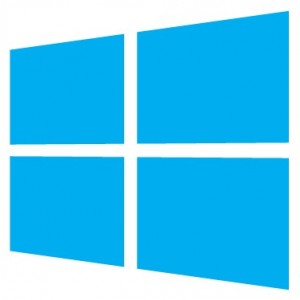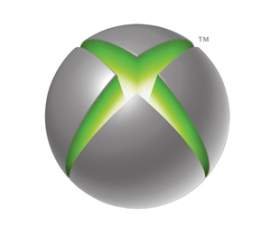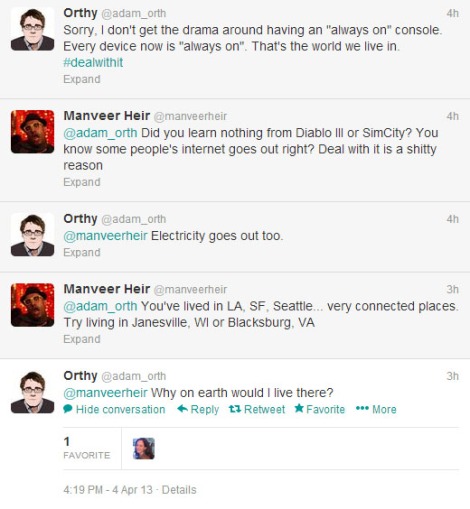Seriously, I’m surprised Microsoft didn’t call their new console the Xbox 180, because that’s what they’ve been doing since their next console’s big reveal. Which is both good and bad really. Good in the sense that they’re actually listening to their customers when it comes to what makes a deal breaker for them. Bad in the sense that this is where Microsoft’s game plan is always going to go on the gaming front, until outside forces (i.e. angry customers threatening sales) stop them and force a course correction.
First came the always-on DRM which outraged consumers – including America’s fighting men and women – causing Microsoft to turn an about face, dropping the always-on and check in once a day requirements. And now yesterday in their latest policy change, the Kinect sensor no longer has to be plugged in for the console to function.
The news came from Chief Xbox One Platform Architect Marc Whitten in an ongoing “Ask Microsoft Anything” segment on IGN, where he addressed users’ Kinect questions yesterday. When asked how “off” the sensor would be when plugged in, Whitten responded that it can be set to “totally” off in the console settings. He went on to state that the Kinect sensor will be optional in games where supplemental content calls for it, but naturally would be required for games that focus on Kinect functionality as the primary mode of gameplay:
You have the ability to completely turn the sensor off in your settings. When in this mode, the sensor is not collecting any information. Any functionality that relies on voice, video, gesture or more won’t work. We still support using it for IR blasting in this mode. You can turn the sensor back on at any time through settings, and if you enter into a required Kinect experience (like Kinect Sports Rivals for instance), you’ll get a message asking if you want to turn the sensor back on in order to continue.
Right – if the word “Kinect” is in the title of the game, you’re going to still need it to play. And this information is all thanks to a user that asked about the always plugged in requirement and what would happen if their sensor broke. Thanks, random user.
According to Whitten and the others who have spoken on Microsoft’s behalf in the past, the Xbox One is still designed to work with the Kinect, not only for gameplay of certain games but for SmartGlass, search, and UI navigation in general. So if you were planning on buying an Xbox One as your new “one” all-serving console, there’s still that stuff you can use it for.
So who knows what’s going on? Maybe they’re feeling threatened by the PS4 and are dropping restrictions to pull in those on the fence outside of the Microsoft die-hards. Maybe they’ve survived a crisis of conscience. Maybe their PR doesn’t want any perception issues after all the recent news and events about digital spying. Either way, this is another 180 from their former draconian policies that console gamers should be able to get behind. That’s not changing their sales strategy though. Even though we now know that the Kinect won’t be required to fire up a game on Xbox One, Microsoft still has no plans of selling the console without it at their $500 price point because of that UI design integration they described. Personally I think selling a non-Kinect version at maybe $400 would get them more sales, because I don’t care how much money you’ve got – $100 is $100. But that’s just me.
I said before publicly that I wouldn’t buy an Xbox One and would go the Sony PS4 route if those old policies from Microsoft remained in place. Now that they’re gone, it’s something I might actually consider.
You know, if I buy a new console at all.
Tushar Nene
Staff Writer
@tusharnene
OK so Microsoft’s been through some interesting times since E3 to now regarding the Xbox One. Seriously, I’m almost tired of typing the name of that console out anymore. First there was the DRM. Then there was the public outcry and backlash. Then they rolled it all back. Then some restructuring. Oh right, and the petitions (most likely of trollish origin) trying to bring back the DRM that Microsoft promised as “the future of gaming.”
Yeah.
So suffice it to say there’s still a lot of people whose living rooms haven’t been won over by the Microsoft show this summer (including me). If I do end up getting one of these next-gen consoles it’s going to be a PlayStation 4 and there’s a lot of people who agree with me. Microsoft knows this though, and they’ve decided to try a different angle – So maybe they can’t have your living room. That’s cool. How abut your office?
Recently on their Small Business support blog, The folks at Redmond are now marketing the Xbox One as the perfect unit for your small to mid-sized business. They threw up some decent points in their defense on a number of things that small and mid-size business can sometimes have some issues with. The first is videoconferencing. There’s not a lot of small businesses that can really swing expensive videoconferencing equipment, and the built in Skype allowing for multi-user chatting could make it attractive for communication. The addition of office web apps as well as plugging into SkyDrive for cloud storage has its draws too. It means documents and media (especially those powerpoint presentations we all love to give) can be pulled up and delivered using gestures instead of clickers or pointers. Given this, $499 isn’t a bad price point for a office machine.
This move and pitch makes sense if we go back to that Microsoft shuffle up for a second. The house the Gates built used to have very separate and very distinct rooms, each covering a product offering – Windows, Office, Mobile, services, etc. As an excerpt from Steve Ballmer’s restructuring memo:
“We are rallying behind a single strategy as one company — not a collection of divisional strategies.”
And that all kind of goes back to the whole “ecosystem” idea that they were pitching a few years ago – becoming a hotel as opposed to houses as it were, if you’ll allow me to make a board game analogue.
Hmm, an interesting thought after all… maybe I can buy an Xbox One and write it off as a work expense? Maybe multiplayer can count as team building…
Tushar Nene
Staff Writer
@tusharnene
 Backpedal (verb): to retreat or move backward.
Backpedal (verb): to retreat or move backward.
Last night the internet saw Microsoft go into full backpedal mode on their DRM practices for the upcoming Xbox One in a post on their site titled “Your Feedback Matters – Update on Xbox One.” The post was courtesy Don Mattrick, the President of Microsoft’s Interactive Entertainment Business unit, and seemed to address a score of concerns gamers had following the product launch event and E3. Citing that his people had heard directly from many fans (read: pages upon pages of ASCII middle fingers on their Facebook page), he announced that DRM practices for the Xbox One would be somewhat rolled back to how they are for the Xbox 360. Here were the main hits:
An internet connection will not be required to play offline Xbox One games – After a one-time system set-up with a new Xbox One, you can play any disc based game without ever connecting online again. There is no 24 hour connection requirement and you can take your Xbox One anywhere you want and play your games, just like on Xbox 360.
Trade-in, lend, resell, gift, and rent disc based games just like you do today – There will be no limitations to using and sharing games, it will work just as it does today on Xbox 360.
This means that if I want to lend my friend a game I just need to give them the disc. Things will mostly roll on like it currently does for the Xbox 360 generation. It’s a good thing that Mattrick and his crew rolled these back if for no one’s sake than their own too, because things were starting to look pretty grim for team Microsoft on the gaming front. Their licensing model was convoluted and strange for borrowing discs and game rentals. Military personnel were calling it “a sin against all service members.” And then there was Sony, their main competition for the last couple generations of gaming consoles, absolutely drilling them on their policies with not only their own business practices but veiled commercials targeting Microsoft to the delight of all watching. I mean we all remember this video on sharing games from PlayStation’s YouTube channel, right?
Did anyone else get a very thumbs up / thumbs down Gladiator vibe from that whole thing? I sure did, and it was hilarity that won in the arena.
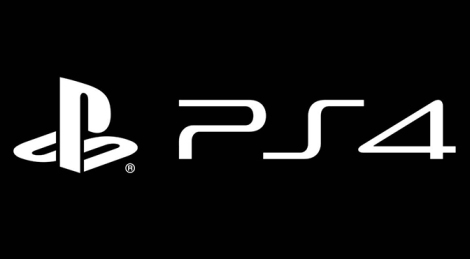 Sony had the pole position in the console press conferences, showing off the PS4 hours after Microsoft was shilling the One. After the disappointment of many after the Xbox One show, Sony had the opportunity to say “Hey guys, don’t worry! We’re still here to save you!” And it worked. Like gangbusters, kids. Sony offered a unit that cost less, had better hardware specs, nixed the DRM, had no requirement for an always on, always listening camera, and didn’t charge $60 a year for online services. How can you lose with that kind of show?
Sony had the pole position in the console press conferences, showing off the PS4 hours after Microsoft was shilling the One. After the disappointment of many after the Xbox One show, Sony had the opportunity to say “Hey guys, don’t worry! We’re still here to save you!” And it worked. Like gangbusters, kids. Sony offered a unit that cost less, had better hardware specs, nixed the DRM, had no requirement for an always on, always listening camera, and didn’t charge $60 a year for online services. How can you lose with that kind of show?
So was it Sony putting pressure on Microsoft by just being themselves or was it truly the Xbox team listening to their fans. “We have listened and we have heard loud and clear from your feedback that you want the best of both worlds,” Mattrick said on the Xbox Wire. Maybe it should have read “Pleas guys, don’t leave us for Sony.” It was probably a combination of both. And that’s what’s awesome about the whole thing. What this showed was that the gaming industry can still be affected by competition and vox populi – even though companies run on margin and greed, that they can shift gears when they previously said they can’t when their dollars are threatened. It’s the beauty of the system – a company can shift gears once they realize that consumers aren’t going for what they’ve got. And to the conspiracy theorists, no, I don’t think this was a planned stunt from the get go to come off harsh then pick up the image of “listening to the fans.” That strategy would have only worked if they had a PS4-killer level function in the Xbox One, which they didn’t. In all I’m glad they rolled back the DRM, but I think the damage is still done.
And that’s my opinion regardless of the borderline insane ramblings of Cliffy B, who claims that it was Sony alone, and not the “whiny internet” that forced Microsoft’s hand.
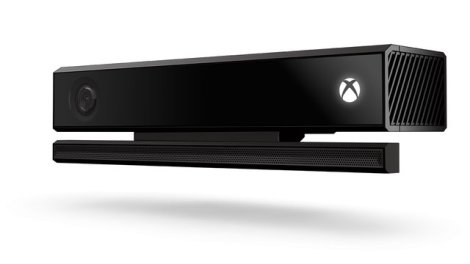 Sony still has a lot of those advantages listed above going for them. The price of the PS4 is still about $100 less than the One, and that also comes with no yearly payments for online services. And money is always a factor. It was part of the reason for the success of Nintendo’s first Wii console after all. But the other disadvantage they still maintain is the Kinect requirement. The Kinect still has to be plugged in and powered on for the console to function, keeping my privacy concerns right where they are. Enough to make the fact that they rolled back the DRM, while fundamentally good, also completely moot. I still need more than “I promise Nene, I’m not listening” to make it happen for me.
Sony still has a lot of those advantages listed above going for them. The price of the PS4 is still about $100 less than the One, and that also comes with no yearly payments for online services. And money is always a factor. It was part of the reason for the success of Nintendo’s first Wii console after all. But the other disadvantage they still maintain is the Kinect requirement. The Kinect still has to be plugged in and powered on for the console to function, keeping my privacy concerns right where they are. Enough to make the fact that they rolled back the DRM, while fundamentally good, also completely moot. I still need more than “I promise Nene, I’m not listening” to make it happen for me.
Final verdict: Sony still has the upper hand.
Tushar Nene
Staff Writer
@tusharnene
 Remember a while back when former Xbox director Adam Orth put his foot in his digital mouth, tweeting to us all that if there is an always on connection (of course before they confirmed it) that we can all #dealwithit? As you know, I had some fundamental problems with the sentiment. Orth went on to be completely dismissive about folks that didn’t have a constant and reliable internet connection. That covers a lot of folks – gamers that live in the rural United States without broadband or have to rely on spotty satellite service as well as members of our armed services that are deployed abroad. I spoke to some of my friends in uniform when that information came out, and they were unanimously unpleased. Gaming is how some of them blow off steam while deployed in remote areas or at sea, and a requirement for online check ins with the inability to play offline without one puts that to an end.
Remember a while back when former Xbox director Adam Orth put his foot in his digital mouth, tweeting to us all that if there is an always on connection (of course before they confirmed it) that we can all #dealwithit? As you know, I had some fundamental problems with the sentiment. Orth went on to be completely dismissive about folks that didn’t have a constant and reliable internet connection. That covers a lot of folks – gamers that live in the rural United States without broadband or have to rely on spotty satellite service as well as members of our armed services that are deployed abroad. I spoke to some of my friends in uniform when that information came out, and they were unanimously unpleased. Gaming is how some of them blow off steam while deployed in remote areas or at sea, and a requirement for online check ins with the inability to play offline without one puts that to an end.
Those statements seem to be resonating with American military personnel. For example US Navy Lieutenant Scott Metcalf, according to reports from The Navy Times, has gone from eagerly awaiting his console’s arrival to not even being sure that he’ll be buying one from Microsoft. The always on policy as well as other aspects of the Xbox are what he calls “showstoppers.” Here’s what a Microsoft spokesperson told the Military Times about Xbox functionality:
“With Xbox One you can game offline for up to 24 hours on your primary console, or one hour if you are logged on to a separate console accessing your library. Offline gaming is not possible after these prescribed times until you re-establish a connection”
The Times outline the other problems that Lt. Metcalf and others have with the new device. For starters, the Xbox One is only supported in 21 countries – meaning it’s unavailable to any personnel deployed outside of those zones. If somehow the lucky military gamer in question is in one of those 21 countries, games are region locked, so guess what? No buying games locally or firing up a disc from home – because if your XBox Live account is linked to a different region, you’re looking at no joy.
More so than the always on component of the console and the inability to play games offline – or even really at all in some cases, is the security issues. This is a huge issue in the past couple weeks, especially considering Germany’s consideration to ban sales of the console considering it a surveillance device. It’s absolutely no surprise to me that the US military feels the same way. In your living room, an always on (and always listening) Kinect unit might pick up a conversation between you and your friends, or where you want to order takeout from. Now imagine that you living room is actually a military unit, where a Commander has a lot more to worry about being picked up than a food order.
Metcalf isn’t the only one with issues. Naval aviator Jay Johnson is outspoken about the topic as well. Johnson, who served tours on three Nimitz-class carriers, describes gaming as “my sanctuary. It is where I went to calm down after a long day of flying.” In a piece he wrote for Gamasutra, he describes it simply as “the single greatest sin Microsoft has committed against all service members.” And he’s right.
 What makes this whole thing even worse is Microsoft’s attitude about the whole thing. While our military personnel are losing a way to escape their sometimes harsh realities, Don Mattrick keeps on with a “sucks to be you” demeanor, stating that if they don’t want a console that has an always on component, that they can always buy an Xbox 360, which allows full-time offline play.
What makes this whole thing even worse is Microsoft’s attitude about the whole thing. While our military personnel are losing a way to escape their sometimes harsh realities, Don Mattrick keeps on with a “sucks to be you” demeanor, stating that if they don’t want a console that has an always on component, that they can always buy an Xbox 360, which allows full-time offline play.
His words in an interview at E3 reflect that:
“When I read the blogs and thought about who’s really the most impacted, there was a person who said, ‘Hey, I’m on a nuclear sub.’ I don’t even know what it means to be on a nuclear sub, but I’ve got to imagine that it’s not easy to get an Internet connection. Hey, I can empathize. If I was on a sub, I’d be disappointed.”
Great, they empathize. Too bad they’re not going to do anything about it. There haven’t been any plans or even words on their part to address the issue. Buthey, they’ve got a 360 for you. It’s absolutely shameful that in a room where these things are discussed at Xbox HQ, there was absolutely no foresight to what their policies could mean for our fighting men and women having a little piece of home when they’re deployed abroad. Said best by Johnson –
“No longer will the sounds of Master Chief saving the human race echo through the hallowed halls of the USS Abraham Lincoln, or any other USS ship, when we have a few hours respite. No longer will you see Marcus and Dom sawing through the Locust Horde at the bases in Afghanistan after the Marines have returned from patrol and want to escape their reality for a bit. Those days are now firmly behind us.”
Tushar Nene
Staff Writer
@tusharnene
 By now you kids know how I feel about always-on DRM. It makes me angry. It makes the fire burn in me belly. And worst of all, it’s a trend that shows no sign of slowing down in the near future. I vented and raged about Diablo III when Blizzard released it last year, seeing white hot flashes of rage at the fact that I couldn’t play my single player game offline. Seemed like a reasonable to me of course, since the game’s predecessor allowed me to do so, but hey, maybe that’s just me.
By now you kids know how I feel about always-on DRM. It makes me angry. It makes the fire burn in me belly. And worst of all, it’s a trend that shows no sign of slowing down in the near future. I vented and raged about Diablo III when Blizzard released it last year, seeing white hot flashes of rage at the fact that I couldn’t play my single player game offline. Seemed like a reasonable to me of course, since the game’s predecessor allowed me to do so, but hey, maybe that’s just me.
As I’m sure we’ve all learned in a number of times in any history class, relationship or other real-life happening, history seems doomed to repeat itself. This time it wasn’t Blizzard at the heart of the controversy though – instead it was EA, one of the OG’s of always-on DRM, and the release of SimCity, next in that line of addictive little sim games. Fans were looking forward to it, and would be erecting tiny digital skyscrapers as we speak if it wasn’t for an absolutely catastrophic launch.
You see kids, the city is a sim. But the horror was real.
 For the last few days since launch, a number of users haven’t been able to connect to the SimCity servers. Of course no connection to the servers means – you guessed it – no SimCity to play. The few players that are in fact able to connect being dropped mid game with a suddenly severed connection. The result? Extremely unhappy gamers. Check out the official SimCity Facebook page to see the kind or ire they drew from their customers. You can take another digital trip over to Reddit where the subreddit /r/SimCity has a ton of discussions between unhappy peoples.
For the last few days since launch, a number of users haven’t been able to connect to the SimCity servers. Of course no connection to the servers means – you guessed it – no SimCity to play. The few players that are in fact able to connect being dropped mid game with a suddenly severed connection. The result? Extremely unhappy gamers. Check out the official SimCity Facebook page to see the kind or ire they drew from their customers. You can take another digital trip over to Reddit where the subreddit /r/SimCity has a ton of discussions between unhappy peoples.
That’s the main story, but it serves as a springboard for a couple of other spinoffs in the SimCity saga. Tuesday on the EA forums (I’d link but it’s since been edited), global community manager Marcel Hatam issued an apology to customers, saying: “If you regrettably feel that we let you down, you can of course request a refund for your order at [Origin’s “contact us” page], though we’re currently still in the process of resolving this issue.”
Then I saw this floating around Twitter. It appears to be a post of a support chat posted to the EA forums by a user going by the handle CalebPeters. In that chat, we see the customer support representative telling the user that EA does allow users to request refunds, but doesn’t necessarily process them by their return policy, also adding that account bans are in store for users that dispute said policy. Of course that chat image went Ebola-style viral across the web immediately after. Marcel Hatan’s forum post has since disappeared, being replaced with the line “Please review our refund policy here: https://help.ea.com/article/returns-and-cancellations” (check poster EA_ComRaven). This of course links to their return policy, which states that there will be no refunds. Through their Origin account (@OriginInsider), EA then clarified that users would not in fact be banned for requesting a refund. PHEW. Three days of whirlwind nuttiness, all because of always-on DRM. But wait, what’s that I hear?
**HERE COMES A NEW CHALLENGER!**
 Enter Amazon into the heart of the melee. Eager to spare their customers from what can only be referred to as a kerfuffle, Amazon has stopped selling SimCity on their storefront. In addition to marking each purchase option as “unavailable” when selected, they give Amazon customers a warning: “Many customers are having issues connecting to the “SimCity” servers. EA is actively working to resolve these issues, but at this time we do not know when the issue will be fixed. Please visit https://help.ea.com/en/simcity/simcity for more information.” Click that screenshot I took to see it full-size or hit up Amazon to see it for yourself.
Enter Amazon into the heart of the melee. Eager to spare their customers from what can only be referred to as a kerfuffle, Amazon has stopped selling SimCity on their storefront. In addition to marking each purchase option as “unavailable” when selected, they give Amazon customers a warning: “Many customers are having issues connecting to the “SimCity” servers. EA is actively working to resolve these issues, but at this time we do not know when the issue will be fixed. Please visit https://help.ea.com/en/simcity/simcity for more information.” Click that screenshot I took to see it full-size or hit up Amazon to see it for yourself.
So EA is trying to address the problem. Naturally, they hate bad press and the prospect of losing future sales as much as the next company. Today they announced that they are removing “non-critical” aspects of the game to help lower the stress on their servers, letting more people connect without getting the boot.
Now this is the second launch that I’ve seen destroyed by a publisher’s absolute insistence on always-on DRM (of course i say “destroyed” due to user backlash, not money). It is also the second launch where the publisher claimed that the always on component provided benefits and was not implemented for DRM reasons. “Oh it’s technical” they say – well I ain’t buying it. Diablo III‘s DRM-laden launch was paired with sales. SimCity will still sell a bunch of copies once they get all this sorted out. That’s two kids. One more always-on DRM launch and I’m ready to call it a horrifying industry trend
On an actual technical note, this was the second launch where AAA publishing houses didn’t properly test a stressed server load. You’re requiring every single player to be online. Don’t you think your servers and network should be beefed up to match it?
Tushar Nene
Staff Writer
@tusharnene


